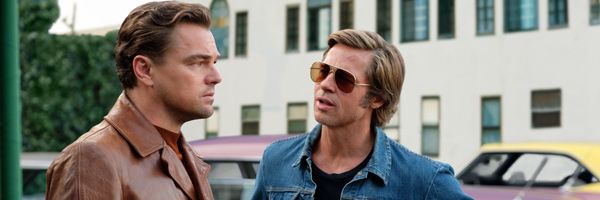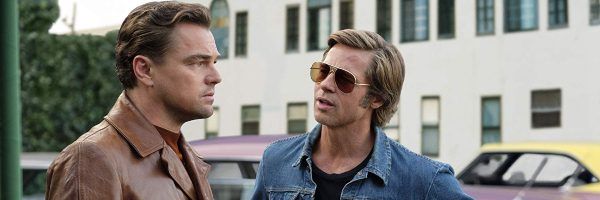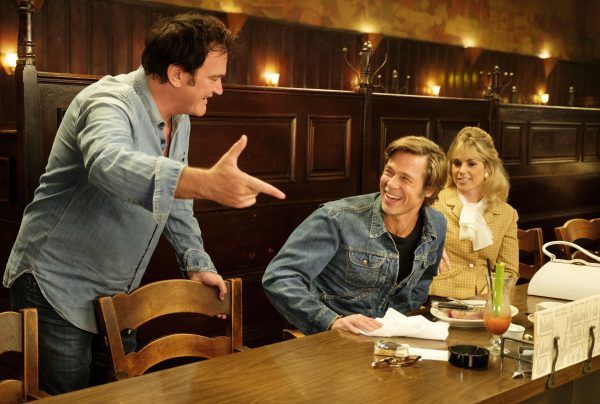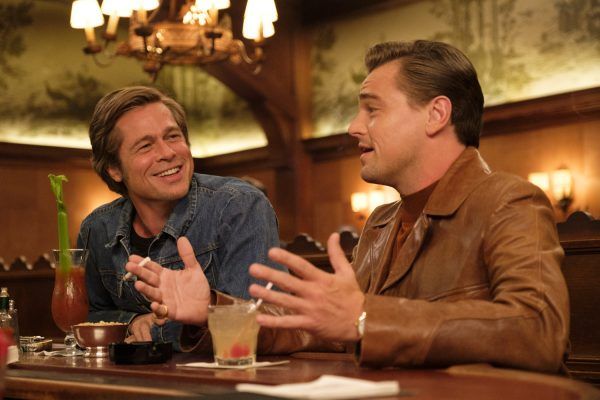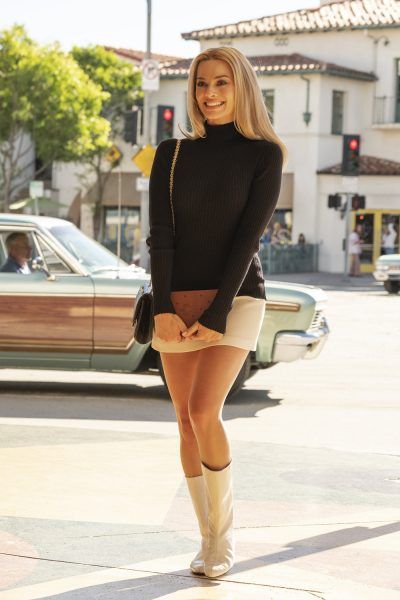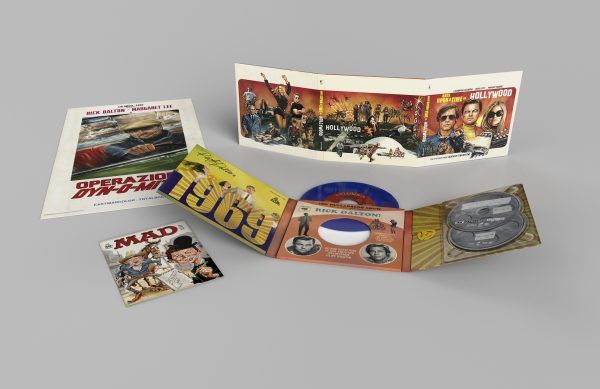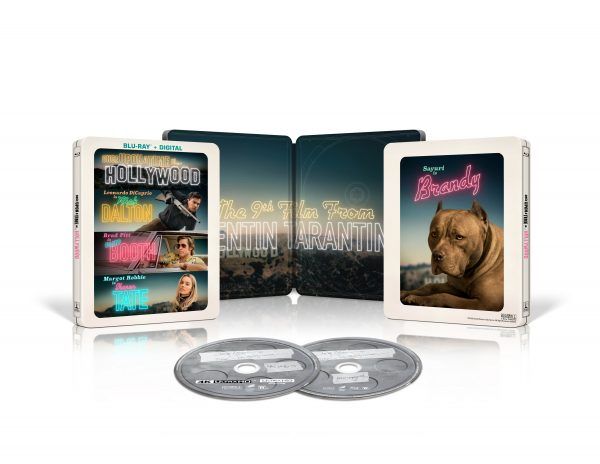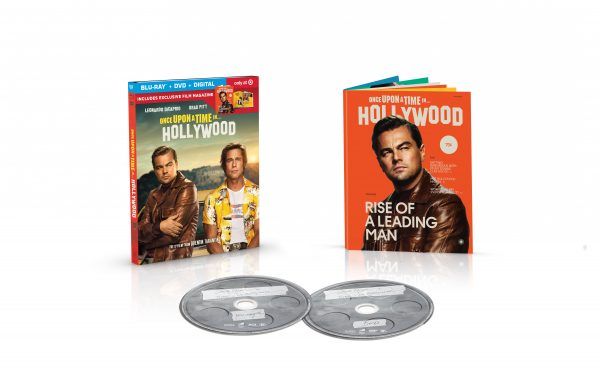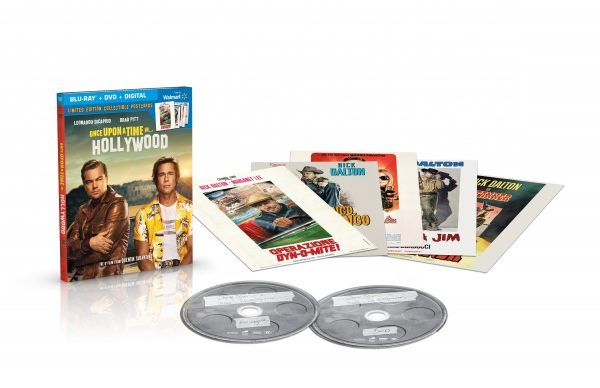On November 2, 2019, I was briefly transported fifty years into the past. I was at the New Beverly Cinema, a classic Los Angeles repertory theatre owned by classic Los Angeles filmmaker Quentin Tarantino, alongside a packed house of other film nerds -- including, quite beautifully, Fred Durst wearing a Limp Bizkit sweatshirt. As we filed into the house, we enjoyed a litany of lobby decorations, concession choices, and pre-show music all impeccably curated from 1969. It was the pitch-perfect, table-setting appetizer to our main course -- a 35mm screening of Once Upon a Time... in Hollywood followed by a discussion with Tarantino and his three stars: Leonardo DiCaprio, Brad Pitt, and Margot Robbie. The occasion, other than a great day at the movies? A celebration of that film's November 26th release on digital platforms, and its handsome array of Blu-ray packages available December 10th.
You can read our review of the film here, so I'll spare you a beat-by-beat recap of my personal second viewing. Just two quick things: One, the film looks good in 35mm. The scratches and reel cue marks add so much to the film's aesthetic pleasures and textual messages. If you want a home video experience close to this (or, better yet, to its limited 70mm screenings), ya better cop that 4K Blu-ray as soon as its available. Two, Al Pacino's Marvin Schwarzs, an agent who takes an enthusiastic liking to Rick Dalton's career, is the closest "actually Quentin Tarantino" character Tarantino has ever written, even more so than characters Tarantino has played. This theory was double-confirmed after seeing the man in action alongside DiCaprio, Pitt, and Robbie in a post-screening chat moderated by filmmaker and historian Jim Hemphill.
Tarantino was, as you might expect, enthusiastic and bombastic, starting the discussion immediately before Hemphill could make any sort of opening remarks. He regaled the crowd with stories, film summaries, and many pitch-perfect impressions and act-outs -- not unlike Schwarzs pretending to shoot up the joint when talking to Rick Dalton. And just like Schwarzs' Rick Dalton film screening, Tarantino told us about his personal 35mm screening room where he took DiCaprio, in his words, "through school." Nobody in the world knows more about every film than Quentin Tarantino, and to help the less educated DiCaprio research his role (Tarantino embarrassed the heck out of poor Leo in front of us, and it was very charming), he screened tons of prints for his star. In fact, one of the first films the two took in was in the New Beverly itself -- a 35mm screening of The Panic in Needle Park, the 1971 drug romance starring, of course, Al Pacino. Tarantino didn't just limit his actors' research to real films -- he also sent DiCaprio and Pitt fake filmographies and bios of Rick Dalton and Cliff Booth to make their shared histories feel as real as possible.
Margot Robbie didn't need any fake filmography, as she plays the very real Sharon Tate in the film. And she found Tarantino's decision to define Tate by life rather than death to be inspiring, calling it "such a joy to go on that exploration." Robbie called Tate "an angel on this earth," and viewed her role in the film -- and the film in general -- as paying tribute to the lightness of 1960s Hollywood, rather than its darkness. Robbie, showing us a glimpse into her process, admitted she tends to find it easier to channel darkness (which we've seen brilliantly in works like I, Tonya). So, to help her find her inner light, she worked with a movement coach, self-deprecatingly telling us of exercises where she "pretended to be a cloud." Robbie also made a list of everything that made her happy and everything that stressed her out. If she knew she was coming to set, she would only focus on things that made her happy the day before, and not do anything on her stress list, like answering emails. Doesn't that just sound a dream?
While on set, a dream came true for DiCaprio, too. He got to meet the late great Luke Perry, who plays real actor Wayne Maunder's role on real Western Lancer, which fake Rick Dalton guest stars in. DiCaprio found Perry to be a "gentle soul," and relished the chance to perform with someone so important to him as a burgeoning actor. If you remember the Lancer sequence from the film, you surely remember a comedic highlight where Rick Dalton trashes his trailer after flubbing his lines on set. That sequence didn't exist in the script -- it was inspired and improvised by DiCaprio himself. DiCaprio suggested to Tarantino that Rick needed more of an arc in the sequence -- he needed to "fuck up" and then redeem himself. Tarantino's initial response? "You're gonna fuck my up Western sequence? I get two-for-one on this one!" However, Tarantino shot the sequence both ways, and realized DiCaprio's "fuck up" was better. Then, they planned the trailer sequence to be as loose as possible, with DiCaprio improvising all of his specifics. Also, DiCaprio teased some stuff left on the cutting room floor that we can only pray is on the blu-ray.
In general, there seems to be a collaborative spirit of playfulness on a Tarantino set, with hanging out and chatting as important, if not more so, than the day's work. As Pitt put it, "The story comes first, then we can get to the scene." Pitt spoke about Tarantino's well-known policy of disallowing cell phones on set, and spilled the beans on one incident shooting Inglourious Basterds. Apparently, someone's cell went off during a shot. Nobody would fess up, but Pitt "knew the general area." And Tarantino reacted, in Pitt's indelible words, as if "someone walked into the Sistine Chapel and took a shit." Tarantino sent everyone home that day, so everyone could "think about what they did." Pitt was full of low-key one-liners like that during the entire discussion. He didn't say much, choosing mostly to peer out into the audience with an expression of bemusement. But when he did, everyone leaned forward. Especially when Pitt told the story of meeting Burt Reynolds, originally cast in Bruce Dern's role before Reynolds' death. Pitt got to hear lots of stories from Reynolds, including about his relationship with his stuntman Hal Needham, and used a lot of what he gleaned in his performance.
This sense of production camaraderie, of artists swapping stories, is what inspired Tarantino to make the film in the first place. While making a previous film with an "older actor" (he didn't mention which film or actor), Tarantino was asked by the actor if he could bring his "guy," a stuntman, onboard to do something. Apparently, this actor brought his guy everywhere he went, and Tarantino obliged, even as he noted the guy being "past his prime." In between takes, Tarantino watched the actor and his stuntman, in identical outfits, "shoot the shit." And something sparked in him. He saw an authentic, lived in relationship -- one he felt that, if he depicted on-screen, could read as living beyond the context of the movie we watch. It's telling that Tarantino's initial spark came from a place of warmth and love. Even when he's depicting absolutely bonkers acts of violence on screen, Tarantino's love for cinema and the people who make it radiates through Once Upon a Time... in Hollywood -- and through the man himself. It was a true pleasure to be briefly transported into QT's world.
If you're interested in revisiting Once Upon a Time... in Hollywood again and again, the specs for each digital and blu-ray release are below, as is a pic from the post-screening discussion. For more coverage of the film, check out our interview with Damon Herriman, who played Charles Manson.
Academy Award winner Leonardo DiCaprio and Academy Award nominee Brad Pitt give “explosively funny and emotionally complex performances” as actor Rick Dalton and his longtime friend and stuntman Cliff Booth, alongside Academy Award nominee Margot Robbie as Sharon Tate in the blockbuster ninth film from writer and director Quentin Tarantino, ONCE UPON A TIME...IN HOLLYWOOD, coming to digital on November 26 and 4K Ultra HD™, Blu-ray™ and DVD December 10.
Also arriving December 10 is a limited 4K Ultra HD Collector’s Edition of the film, sure to make any Tarantino fan’s holiday wish list. Premium collectible packaging will contain a 7” vinyl record with two of the soundtrack’s grooviest tunes (complete with turntable adapter), a collectible vintage poster for the Rick Dalton film Operazione Dyn-o-mite! and an exclusive new MAD Magazine parody of the Rick Dalton TV series “Bounty Law,” Lousy Law. The collector’s edition is available for pre-order today from Amazon.com, Walmart.com, BestBuy.com and Target.com.
The 4K Ultra HD, Blu-ray, DVD and digital releases come loaded with even more sights and sounds of the ‘60s, featuring over twenty additional minutes of footage that delves deeper into world of Rick Dalton’s Hollywood. The 4K Ultra HD, Blu-ray and digital include an additional behind-the-scenes look at the film’s production design, cinematography, costume design, cars and more.
Collectors will also be delighted by exclusive packaging and gifts-with-purchase offered at retail for the film’s Blu-ray release. These include “Rick Dalton” movie poster cards available at Walmart, a vintage-style film magazine with over 26 never-before-seen production photos available at Target and a collectible steelbook available at Best Buy. All exclusive offerings are available for pre-order today.

